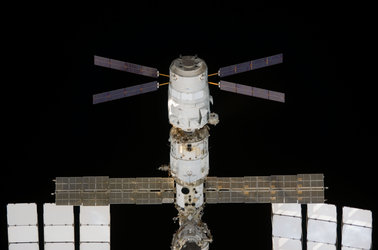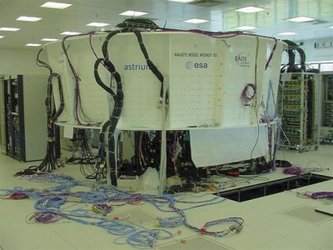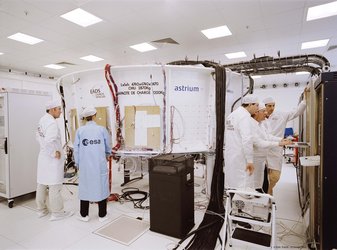Go-ahead given to deliver Russian ATV hardware
Meeting on 9 July in Moscow, senior representatives of the European Space Agency (ESA), the Russian Rocket Space Corporation Energia (RSC-Energia), EADS SPACE Transportation and Alenia Spazio gave their consent to deliver to Europe the Russian Equipment Control System, for the new European-developed Automated Transfer Vehicle (ATV).
The system controls all the mechanical Russian docking systems of the ATV during rendezvous, as well as the in-orbit refuelling operations during the attached phase with the Space Station. It also plays a major role in ATV undocking after being attached to the ISS for up to six months.
Integration

Built in Korolyov near Moscow by RSC-Energia, the Russian Equipment Control System will be installed in the pressurised Cargo Carrier module of the ATV Jules Verne, which docks with the ISS. Shipped in about 20 boxes ranging from 10 to 50 kg, the system will be integrated in ESA Noordwijk into the first ATV flight model with the participation of RSC-Energia engineers and technicians.
“This is the last important piece of hardware, built by the Russian Rocket Space Corporation Energia, to be shipped for ATV integration to ESA’s test facilities in Noordwijk, the Netherlands, and it represents a major step in cooperation with Russian industry”, said Robert Lainé, ESA’s ATV programme manager, at a press conference in ESA’s Moscow Office. “We really appreciate the efforts, dedication and incredibly long hours that RSC-Energia teams have put into designing, building and testing the electronics of the Russian Equipment Control System. For the past several months, about 150 Russian engineers and specialists have been working in three shifts, 24 hours a day and 7 days a week.”
Joint project

For the first time, ESA, European aerospace companies and Russian engineers of RSC-Energia have been developing a new space technology together. This new technology, which has been more than five years in development, will fly in 2007 on board the first ATV, called Jules Verne, towards the International Space Station (ISS).
“The development of this joint project for the ATV has been difficult because of the high level of technology, but it has been a fruitful exchange of technical knowledge, beneficial to both sides,” said Yuri Semenov, president of RSC-Energia. “What we have developed in this project, such as the digital technology, we will be able to use for other projects in the future”.
Supply spaceship

The ISS depends on regular deliveries of experimental equipment, propellant and spare parts as well as food, air and water for its crew. From the second half of 2005 onwards, Europe's ATV will become one of the ISS supply spaceships.
Every 14 months, the ATV will carry up to 9 tonnes of cargo to the International Space Station 400km above the Earth. It will be launched into orbit by an Ariane 5 launcher from Kourou, the European Spaceport in French Guiana. An on-board high precision optical navigation system will guide the ATV to the ISS, where it will automatically dock with the Station's Russian service module, Zvezda. The ATV will remain there as a pressurised and integral part of the Station for up to six months until the completion of its mission by a one-way trip into the Earth's atmosphere to dispose of up to 6.3 tonnes of waste and material that is no longer needed on the Station.
Industrial companies
Under contract by ESA, the ATV project involves dozens of industrial companies from ten European countries, led by prime contractor, EADS SPACE Transportation. It also implicates the cooperation of 8 companies from Russia, whose main contractor is RSC-Energia, which has built the ATV docking mechanism, the refuelling system and the associated electronics of the Russian Equipment Control System. The Russian-built ATV docking mechanism and the refuelling system were already delivered to EADS SPACE Transportation last summer.








